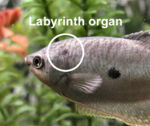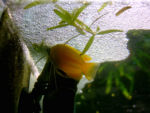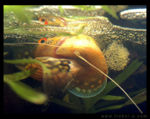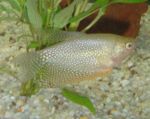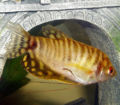Gourami
| Gourami |
|---|

|
| Scientific Classification |
|
| Genera |
|
Subfamily: Belontiinae Subfamily: Luciocephalinae Subfamily: Macropodinae Subfamily: Osphroneminae |
Gourami are popular tropical fish found in most pet stores, and in particular the Betta. Their popularity is in no small part due to their extraordinary colors and unique ability to tolerate murky or poorly oxygenated waters.
Some perhaps less familiar breeds of Gourami are the Dwarf Gourami, the small colorful Paradise fish, the strange finned Giant Gourami, and the most unusual of the family is the Makropode. [1]
Aggression

Although the reasons are unknown, this Family of fish seems to be particularly violent and independent. This is seen mainly in the males, who pick on the smaller fish in the vicinity, and even kill them in some cases. The Gourami has many special features, but no real defenses. What is so miraculous is their ferocity seems to be the only defense this small fish has. Although, some species of Gourami do have camouflage to help them stay hidden from predators. [2]
Anatomy
Among the many spectacular adaptations of the Gourami, the foremost is the labyrinth organ that allows them to breathe in a unique way. This labyrinth organ is a means of respiration that is specialized to the Anabantoidei family. This organ is folded and compressed, but when the fish fills it full of air it expands and has a more concentrated air source. It is allowed more freedom from constant submerging to the surface of it's water source. The fish can do this because these lungs are used for pulling air out of the atmosphere instead of pulling it out of the water. [3]
Reproduction and Young
A wonder of the family Gourami is the presence of their bubble-nest mating technique. The bubble nest is created by the male. The male Gourami coats each bubble with saliva for "durability" and clumps them in a group on the waters surface.
The male and female Gourami will spawn (or mate) and the fertilized eggs are put into the secure bubble nest by the male. He is the one doing all the parenting in this process. He will bring each individual egg into the nest and secure it there. Then he protects the nest by chasing away predators (that includes the females as well). He also tends to the bubble-nest by replenishing it will bubbles periodically. It must be thick for the eggs. The babies will need to live in them for one to two weeks after they hatch. The male is there the whole time, nurturing the babies. [4]
Ecology
Gourami usually feed on bugs and sometimes smaller fish. They are native to Indonesia, and were later introduced to the Asia and Asia Minor waters. Their special lung structures make them adept to living in less-oxygenated waters such as lakes and rivers. Some species of the male Gourami have been recorded as making croaking noises when they surface for air. This is still mystifying scientists. Another interesting aspect of the Gourami's life is the presence of their frog-like qualities besides the croaking. Many Gouramis also have lip-like structures similar to that of frogs. [5]
Special Species
We all know about the beautifully volatile Siamese fighting fish, but a lesser known species like the Pearl fish are just as interesting and special. The Pearl fish is named for the pearl-like lacy fins cascading from the posterior region. Similar with many colorful animals of Gods kingdom, the Pearl fish's spotted, orange coloring is specialized to only the males. These fish require freshwater, and live in rivers and lakes in Asia and Asia Minor (Thailand, Malaysia, Sumatra, and Borneo). [6]
The Paradise fish is a beautiful aquatic species. They are extremely special to fish collectors, having been one of the first tropical species to be available for "western" pet owners. Like their relative, the Chinese Fighter fish, these animals prefer solitude and are prone to killing small animals in their habitat. These animals also reproduce by means of a bubble-nest. They are an average of three inches long, and can live in rather cold environments for their tropical background. [7]
Gallery
Related References
- GouramiWikipedia
- Pearl GouramiWikipedia
- Paradise FishWikipedia
- Gourami Bartleby
- Bubble NestWikipedia
- Labrynth Organ Wikipedia
Good Gourami Images
